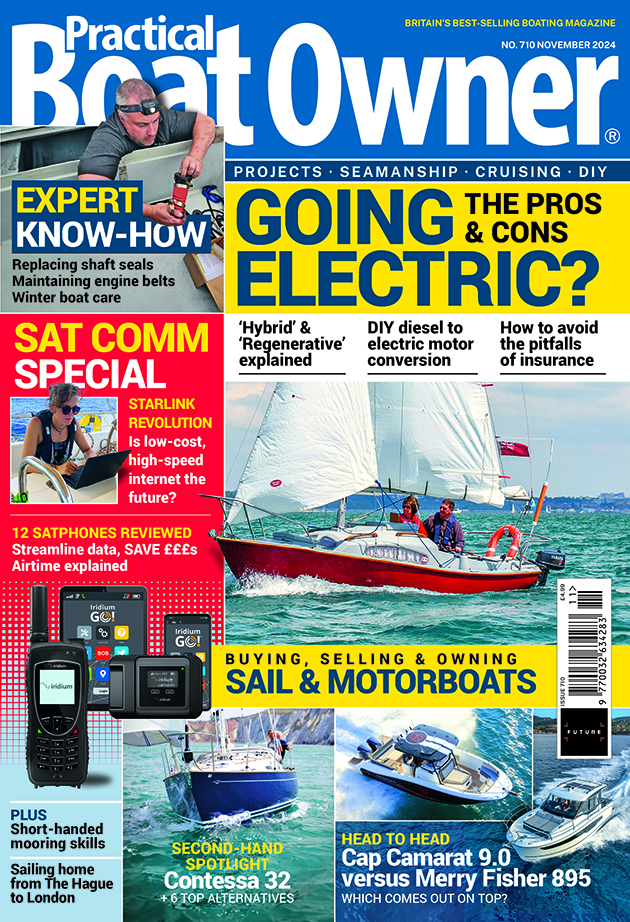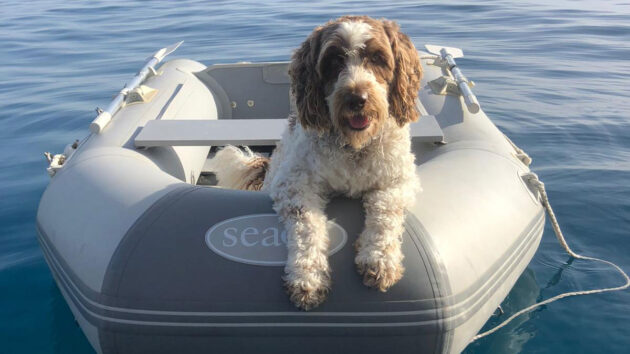Zoe Barlow and husband Martyn quit their jobs for a liveaboard adventure on their Sun Odyssey 40 with their dog, Ralph. They share their tips for sailing with a dog
Our sailing adventure to the Mediterranean back in 2021 had the challenges of being in the aftermath of COVID restrictions and Brexit. Not only this but we were sailing with a dog – Ralph, our four-year-old Sproodle.
Having read other people’s experiences and the advice on Gov.uk relating to travelling with animals to France, Spain, Portugal, Morocco, Tunisia, Italy and Malta, I was apprehensive, to say the least, but we couldn’t leave him behind so it was a case of let’s set sail and see what happens.
Sailing with a dog: Pet passport/Animal Health Certificate
Brexit had made Ralph’s British Pet Passport obsolete, so he had to have an Animal Health Certificate [www.gov.uk/taking-your-pet-abroad/getting-an-animal-health-certificate].
It’s the same document with a different name but only valid for four months.
We bought one at the only vet in the Isles of Scilly who also administered tapeworm treatment necessary before travelling to Europe [www.gov.uk/taking-your-pet-abroad/tapeworm-treatment-for-dogs].

All dogs leaving Great Britain (England, Wales and Scotland) to an EU country or Northern Ireland need an Animal Health Certificate to travel. Credit: Zoe Barlow
This must be done within five days of arrival. It all cost £120.
The vet also checked Ralph’s rabies jab was in date.
It is stated on the Health Certificate that it must be stamped on arrival in Europe.
However, I had to get the legislation, in French, on my mobile phone before the officials obliged.
Luckily, we found a vet in Portugal (where we overwintered) who issued Ralph with a Portugese Pet Passport, but in all of the seven countries visited none of the immigration authorities wished to see it.
Returning to Great Britain is more complicated, as on a yacht, a dog can only arrive in Great Britain on a private boat if it is arriving from Northern Ireland, the Channel Islands, the Isle of Man or the Republic of Ireland.
Where does he ‘go’?
It’s a two-day crossing from France across Biscay to Northern Spain.
Getting dogs ‘to go’ on long passages can be a real problem as dogs are clean and habitual animals and will hold it as long as they can!
Ralph has been used to sailing with us from six months old but even so, he would hold it for 24 hours.

Make sure your dog is comfortable with being on a boat. Credit: Zoe Barlow
The breakthrough came when my husband relieved himself in front of the mast and so Ralph did the same, and now that’s where he will go.
A sluice down with a few buckets of seawater soon clears the decks.
This can be a bit of a mission if there is swell but he will not go in the cockpit! Some sailors swear by Astroturf.
Exercise
It really helps if your dog likes swimming, as sometimes this may be the only way to exercise them. It also helps to cool them down.
If you can anchor near a wooded area, the shade makes for a comfortable walk.
On passages, we played games with Ralph to help tire him out.

The incredible turquoise water in the Balearics – swimming time! Credit: Zoe Barlow
Due to the heat, to have a proper walk we needed to be out by 7am.
Unfortunately, in the majority of the countries we visited dogs are not allowed on beaches in the summer.
We’d take Ralph ashore first thing or later in the evening but it did mean that during the day we were stuck on the boat.
Dog’s dinner
Before we left the UK, Ralph was on a raw food diet which was going to be unsustainable on a boat without a massive freezer.
We decided to go with kibble mixed with a tin and it worked well.

Gourmet dog food awaits dogs that travel to Italy. Credit: Zoe Barlow
The most expensive dog food was in Italy – a gourmet selection including Japanese or Greek-inspired kibble!
In Tunisia, it was £3 for a small tin which was more expensive than a chicken so Ralph ate a lot of chicken and rice that stay.
We’d hoped to supplement Ralph’s diet with freshly caught fish, but sadly didn’t catch a single thing!
Out and about
The attitude to dogs in different Mediterranean countries varies massively, and this impacts your ability to use public transport, eat in restaurants, shop and go to the beach.
We found Italy to be the most welcoming – it was easy to take Ralph into a restaurant and even into a supermarket, albeit in a trolley.
Travelling on buses was problematical wherever we went with some drivers happy to take him but others not.

Not all places welcome dogs so you may be limited to where you can visit. Credit: Zoe Barlow
If you have a smaller dog you can take them in a bag but Ralph at 16kg was too big.
In Portugal, only a few restaurants would allow Ralph inside. He was permitted on the trains with a muzzle but we had to show his Pet Passport to buy him a ticket!
Our experience was that the North Africans either loved Ralph or were terrified of him.
He was seen as an oddity as although there are dogs around they are not as curly or fluffy.

Ralph was popular in Morocco and Tunisia. Credit: Zoe Barlow
We cannot count how many times we were stopped by people both in Morocco and Tunisia to ask if they could have their photo taken with him.
There were many stray dogs, some friendly, some threatening. Ralph had a few favourites he would play with on our daily walks.
It was a relief to get to Malta; here, every dog we saw was accompanied by an owner.
Keeping cool
With temperatures nearing 40°C at times we had to find ways of keeping Ralph cool, especially on passage when he couldn’t jump in for a swim.
Ralph found most of the shady spots on the deck and benefitted from a cold coat which just needed wetting in cold water to stay damp for ages.

Ralph snoozing in the shade. Credit: Zoe Barlow
A cool mat, which you keep in the fridge, was effective at night when the temperature was still in the late 20s or even warmer inside the boat.
My husband became adept with the scissors keeping Ralph’s woolly coat trim.
Those with dogs who shed hair would definitely struggle when living on a boat!
Healthcare
It’s important to keep up with all the normal worming, flea and tick treatments and rabies injections.
Some medicines were available from pet shops and if we did need to use a vet it was much cheaper than in the UK.

Make sure you keep with routine healthcare while sailing with your dog – so he can enjoy cruising too. Credit: Zoe Barlow
A rabies shot in Portugal for example was €25. Ralph developed an eye problem in Portugal but it was quickly and professionally dealt with.
Our pet insurance back in the UK didn’t cover us for more than three months abroad. Any policy that would cover him was prohibitively expensive.
Useful information for sailing with a dog
- Get your dog used to sailing before you go, the earlier you start the better. Invest in a comfortable pet lifejacket.
- Make them a cosy spot in the cockpit where there is shade. Ensure your dog can handle the companionway steps so they can be independent.
- Get them used to toileting on the boat by training them off the boat with Astroturf, then bring it on board.
- Get the paperwork in order.
- Ensure you know what each country requires in terms of vaccination and treatments. Your vet can assist with this.
- If your dog is on long-term medication, take enough with you to last your trip
- Consider investing in a cool coat and mat for your dog.
- If your dog usually needs grooming, get your own clippers and practice doing it yourself. We could find dog groomers in Europe but not in North Africa.
Dog lifejacket test – Paddleboard with your dog!
Dog lifejackets are designed to allow dogs to swim comfortably, and are made of foam to support key areas of…
Sailing in Europe after Brexit: the essential guide
Planning on sailing in Europe? The Cruising Association shares its advice on what you need to know for a stress-free…
Boating with dogs – essential sailing gear for your seadog
Having the right dog sailing gear is an important part of keeping your four-legged friend happy. Any dog can be…
Seadogs: 10 top tips for sailing with dogs
Sailing round the world with dogs requires months of preparation and research, stacks of paperwork, extra supplies and provisions, regular…
Want to read more practical articles like Sailing with a dog in the Mediterranean?

A subscription to Practical Boat Owner magazine costs around 40% less than the cover price.
Print and digital editions are available through Magazines Direct – where you can also find the latest deals.
PBO is packed with information to help you get the most from boat ownership – whether sail or power.
-
-
-
- Take your DIY skills to the next level with trusted advice on boat maintenance and repairs
- Impartial in-depth gear reviews
- Practical cruising tips for making the most of your time afloat
-
-
Follow us on Facebook, Instagram, TikTok and Twitter








